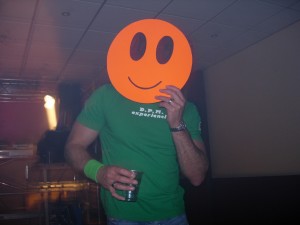________________________________________________________________________________
It's ridiculous to claim that video games influence children. For example, if PacMan affected kids born in the eighties/nineties we should by now have a bunch of teenagers running around in darkened rooms, eating pills while listening to monotonous electronic music.
________________________________________________________________________________
Techno:
Techno features a largely percussive feel, like the synthetic sounds, studio effects used as principal instrumentation, and usually a regular 4/4 beat with a tempo of 130–140bpm, sometimes faster, but rarely slower. Some techno compositions have strong melodies and bass lines, but these features are not as essential to techno as they are to other styles of electronic dance music, and it is not uncommon for techno compositions to deemphasize or omit them. Techno is also very DJ-friendly, being mainly instrumental, and produced with the intention of being incorporated into continuous DJ sets wherein different compositions are played with very long, synchronized segues. Although several other dance music genres can be described in such terms, techno has a distinct sound that aficionados can pick out very easily.
There are many ways to make techno, but a typical techno production is created using a compositional technique that developed to suit the genre's sequencer-driven, electronic instrumentation. While this technique is rooted in a Western music framework (as far as scales, rhythm and meter, and the general role played by each type of instrument), it does not typically employ traditional approaches to composition such as reliance on the playing of notes, the use of overt tonality and melody, or the generation of accompaniment for vocals. Some of the most effective techno music consists of little more than cleverly programmed rhythmic foundations and musical phrases that interplay with different types of special signal processing and frequency filtering, mixed in such a way that it is not easy to distinguish the natural timbre of an instrument from the digital effects applied thereto.
Instead of employing traditional compositional techniques, the techno musician, usually acting as producer, treats the electronic studio as one large, complex instrument: an interconnected orchestra of machines, each producing timbres that are simultaneously familiar and alien. Each machine is encouraged to generate or complement continuous, repetitive sonic patterns that come relatively 'naturally' to them, given the capabilities and limitations of early sequencers — such sequencers, especially those built-in to old drum machines, tend to encourage the production of repeating 16-step patterns with a limited number of instruments being playable at once, yet they also allow sounds to be arranged in any order, regardless of whether live musicians could easily reproduce them. Rather than just mimicking arrangements playable by live musicians, the techno producer is free to prominently feature unrealistic combinations of sounds. Most producers, however, strive to achieve a listenable, dancefloor-friendly balance of realistic and unrealistic arrangements of mostly synthetic, semi-realistic timbres, rather than a demonstration of machine-powered extremes.
After an acceptable palette of compatible textures is collected in this manner, the producer begins again, this time focusing not on developing new textures but on imparting a more deliberate arrangement of the ones he or she already has. The producer "plays" the mixer and the sequencer, bringing layers of sound in and out, and tweaking the effects to create ever-more hypnotic, propulsive combinations.



